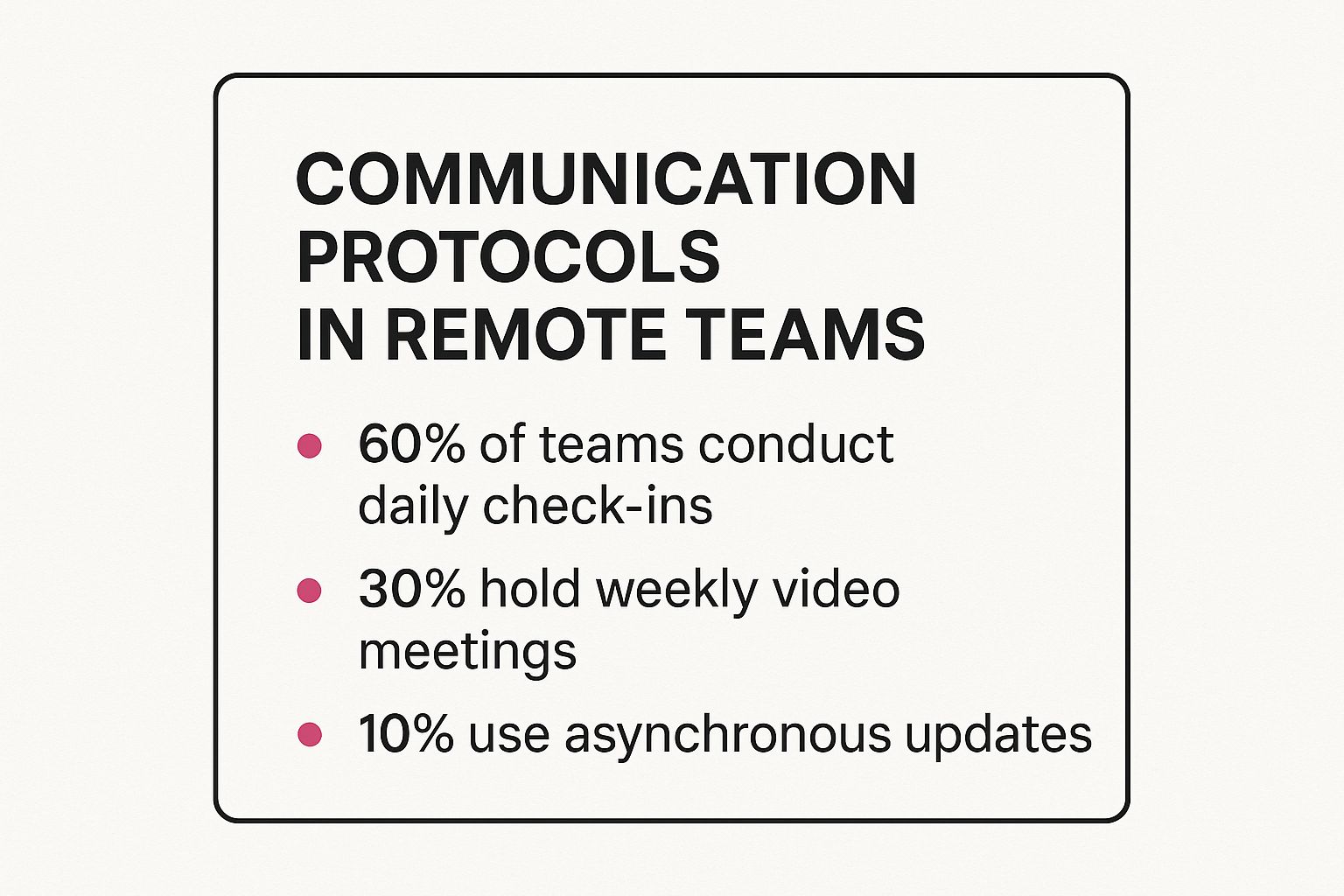Managing Remote Teams: Tips for Virtual Leadership Success
Max
The Remote Revolution: Navigating the New Normal

The modern workplace has broken free from the traditional office. This shift to remote work offers businesses access to a global talent pool and provides employees with greater flexibility. However, it also requires a fundamental shift in how we manage teams.
Successfully navigating this new normal means adapting our leadership styles, communication strategies, and performance management frameworks. We need to rethink how we connect with our colleagues, foster collaboration, and achieve results in a distributed environment. Ultimately, adapting to the remote revolution is about empowering teams to thrive, no matter where they are.
Embracing the Changing Dynamics of Remote Teams
The transition to remote work isn’t just logistical; it’s a cultural transformation. Managing remote teams effectively requires understanding the unique challenges and opportunities this presents. Communication, for instance, becomes paramount. Leaders must establish clear communication protocols and use technology like Slack or Microsoft Teams to ensure seamless information flow and maintain team cohesion.
Building a sense of belonging and shared purpose can be harder when team members are geographically dispersed. Proactively building a digital team culture is key to long-term success.
The Rise of Remote Work and Its Impact on Leadership
The global shift towards remote work has accelerated dramatically in recent years. In 2020, roughly 13% of the global workforce was remote. That number jumped to 28% by 2023. This growth signifies a profound change in business operations and employee preferences.
In the United States, for example, about 22.8% of employees worked remotely at least part-time as of August 2024. This shift is valued not only for its flexibility but also for its potential to boost productivity. Studies have shown that remote work doesn’t hinder productivity, with some reporting increased efficiency when working from home. You can find more detailed statistics here: https://www.splashtop.com/blog/remote-work-trends-2025. This trend requires leaders to develop new skills in virtual communication, performance management, and building trust across distance.
Adapting to the Demands of a Distributed Workforce
Managing a remote team also requires rethinking traditional performance metrics. Instead of focusing on attendance, leaders should prioritize outcome-based assessments that measure meaningful contributions and results. This means setting clear expectations, providing regular feedback, and creating a culture of accountability without resorting to micromanagement.
Addressing work-life balance and preventing burnout in a remote setting is also critical. This involves encouraging healthy boundaries, promoting self-care, and fostering a supportive team environment. By addressing these factors, organizations can unlock the full potential of their remote teams and achieve sustainable success in the ever-evolving world of work.
Mastering Virtual Communication: Beyond Basic Tools

Effective communication is the cornerstone of any successful remote team. This means going beyond the basics of video conferencing and instant messaging. To build a truly robust virtual communication ecosystem, we need a deeper understanding of communication styles and a well-defined plan. This approach will foster clarity, stronger connections, and ultimately, a more productive team. The infographic below summarizes these key points for building strong communication within a remote team. We’ll explore these points in greater detail below.
Synchronous Vs. Asynchronous Communication: Finding the Right Balance
Communication can be broadly categorized into two types: synchronous and asynchronous. Synchronous communication, like video meetings, happens in real-time, requiring everyone to be present at the same time. This is ideal for brainstorming sessions, critical decision-making, and important team-building activities.
Asynchronous communication, on the other hand, allows team members to contribute at different times, using tools like email or project management platforms like Asana. This method promotes flexibility and respects varied schedules, which is especially important for teams spread across different time zones.
Successfully managing a remote team hinges on striking the right balance between these two communication methods. This prevents communication overload while ensuring timely information flow. For example, a quick daily stand-up meeting (synchronous) could be followed up with project updates posted on a shared platform (asynchronous).
Establishing Clear Communication Protocols
Clear communication protocols are essential for effective teamwork in remote settings. These protocols act as a guide, defining how, when, and where team members should interact. This clarity minimizes ambiguity and creates a more structured communication environment.
These protocols could define the preferred channels for different types of communication, establish guidelines for meeting etiquette, or set expectations for response times. Ultimately, this builds trust and transparency within the team. When everyone is aware of the communication expectations, individuals can manage their time and focus more effectively, leading to better collaboration and overall team performance.
Key Takeaways for Effective Virtual Communication
Here’s a quick reference for building strong communication within your remote team:
Embrace Both: Utilize both synchronous and asynchronous communication methods.
Establish Clear Protocols: Set clear guidelines for how your team communicates.
Break Down Silos: Utilize shared platforms and encourage open communication.
Foster Connection: Create opportunities for casual interaction and team building.
This strategic approach to communication not only improves collaboration and productivity but also enhances team morale and job satisfaction. Mastering virtual communication builds a solid foundation for a thriving remote team, one that’s ready to tackle any challenge.
Building Digital Team Culture That Actually Works
 Creating a thriving team culture in a digital environment requires a proactive and thoughtful approach. It’s about cultivating a sense of belonging and shared purpose, even when team members are geographically dispersed. This goes beyond occasional virtual social events and gets to the heart of how we connect and build community online. It involves understanding the unique needs of a remote workforce and implementing strategies that encourage genuine interaction.
Creating a thriving team culture in a digital environment requires a proactive and thoughtful approach. It’s about cultivating a sense of belonging and shared purpose, even when team members are geographically dispersed. This goes beyond occasional virtual social events and gets to the heart of how we connect and build community online. It involves understanding the unique needs of a remote workforce and implementing strategies that encourage genuine interaction.
Fostering Connection and Belonging in a Virtual Space
Building meaningful relationships remotely requires more than just scheduled meetings. It necessitates creating opportunities for spontaneous interaction and organic connection. Think of the casual conversations that occur in a physical office—those moments that build rapport. How can we replicate this virtually?
Successful remote teams often utilize tools like dedicated Slack channels for non-work discussions or virtual coffee breaks to encourage informal interactions. These practices help combat feelings of isolation and foster a sense of community. This intentional effort is what sets a truly connected team apart.
Establishing Psychological Safety in Digital Environments
Psychological safety, the comfort in taking interpersonal risks, is essential for remote teams. It means creating an environment where team members feel comfortable expressing their opinions, sharing ideas, and asking questions without fear of judgment. This is especially important in remote settings where miscommunication can easily happen.
Leaders can foster psychological safety by actively encouraging open communication, valuing diverse perspectives, and modeling respectful interactions. This builds trust and cultivates a more collaborative and innovative team dynamic. For instance, regularly soliciting feedback and responding constructively demonstrates that team members’ voices are valued.
Inclusive Practices for Preventing Isolation
Inclusive practices are critical for remote teams, especially given the potential for isolation. This means proactively designing team activities that cater to diverse personalities and preferences, ensuring everyone feels valued and included.
However, fostering inclusivity also means recognizing and respecting individual needs for quiet time and focused work. It’s a delicate balance between encouraging connection and respecting boundaries. Offering a variety of social activities, some structured and some more informal, allows individuals to choose what suits them best. This balance is key for a sustainable and supportive remote work environment, and it’s important for talent retention. Employee preferences are crucial for the continued growth of remote work, with 81% of workers considering it a top factor in a job, even surpassing salary. Find more detailed statistics here: https://www.roberthalf.com/us/en/insights/research/remote-work-statistics-and-trends.
Building Traditions and Celebrating Successes Remotely
Creating traditions that strengthen collective identity is a powerful way to build remote team culture. Just because a team is virtual doesn’t mean it can’t have shared experiences. These can include regular virtual events, unique team rituals, or even established ways of celebrating successes.
These shared experiences foster a sense of belonging and create lasting memories. It’s like building a shared history, even without a shared physical space. This strengthens team bonds and contributes to a strong, positive team identity. Celebrating individual and team achievements through virtual award ceremonies or personalized recognition can significantly boost morale and build a sense of shared accomplishment. Ultimately, a thriving remote team culture is built on intentional practices that foster connection, belonging, and a shared purpose, creating a true community.
Measuring What Matters: Remote Performance Frameworks

Traditional performance metrics, often based on being physically present in the office, don’t translate well to the world of remote work. This can be frustrating for managers trying to evaluate contributions and for team members who feel their work isn’t being assessed fairly. Managing remote teams effectively means shifting the focus from activity to outcomes. It’s about measuring meaningful results and value, not just hours logged online.
Embracing Outcome-Based Assessments
Outcome-based assessments are key to successful remote performance management. This method emphasizes the results delivered, rather than the time it took to achieve them. This makes perfect sense for remote teams, where flexible schedules and asynchronous communication are common. Instead of checking how long someone is online, concentrate on the quality and impact of their work.
This shift requires clear communication of expectations and measurable goals. Focusing on delivered value creates a culture of accountability and empowers remote team members. It allows them to manage their time and workflow effectively, boosting both morale and productivity.
Setting Clear Expectations and Providing Contextual Feedback
For remote teams to thrive, clear expectations are essential. This means outlining specific, measurable, achievable, relevant, and time-bound (SMART) goals. It’s also important to provide context for these goals, showing how they contribute to the larger team and organizational objectives. When everyone understands what’s expected and how their work fits into the bigger picture, the team functions more smoothly.
Regular, contextual feedback is even more critical in a remote environment. Focus on specific tasks or projects, and offer constructive criticism. This helps remote team members understand their strengths, identify areas for improvement, and stay on track with team goals.
Building Trust and Accountability Through Transparent Communication
Open communication is fundamental for building trust and accountability in remote teams. Share performance data transparently, and provide clear explanations for any evaluation decisions. A transparent evaluation process reduces anxiety and builds a sense of fairness.
Regular one-on-one meetings are also invaluable. They help build rapport, address any performance concerns, and identify development opportunities. Structure these meetings, but also allow for open discussion, creating a safe space for remote team members to share challenges and receive individual support. Addressing potential performance issues early prevents them from becoming bigger problems down the road.
Using Performance Data to Enhance Team Effectiveness
Performance data isn’t just for individual reviews. It’s also a valuable tool for boosting team effectiveness. Analyzing trends in performance data can reveal both team strengths and areas for improvement. This data-driven approach informs strategic decisions and promotes continuous improvement.
Use this data responsibly. The goal is to encourage growth and provide support, not to create a culture of surveillance. Frame performance data as a tool for improvement, and you’ll empower your remote team to achieve its full potential.
Conquering Remote Leadership Challenges Head-On
Managing remote teams presents unique challenges. These go beyond the typical issues faced in traditional office settings. Leaders must develop strategic solutions to maintain productivity, engagement, and employee well-being. This includes understanding the specific obstacles that can arise in virtual work environments. These range from digital burnout to maintaining team visibility and resolving conflicts across distances. Effectively addressing these challenges is essential for any organization embracing remote work.
Overcoming the Hurdles of Virtual Environments
Effective remote leadership means tackling the common obstacles faced by remote team leaders. One major challenge is preventing digital burnout. This is a state of emotional, physical, and mental exhaustion brought on by over-reliance on technology. Leaders need to encourage healthy work habits. This includes promoting regular breaks and setting clear boundaries between professional and personal time.
Maintaining team visibility without micromanaging is another significant hurdle. Leaders must strike a balance between necessary oversight and giving team members the autonomy to excel. Clear performance metrics and a focus on outcomes, rather than constant surveillance, create accountability without stifling innovation.
Conflict resolution can also be more complex in remote settings. Misunderstandings and miscommunication are more frequent without face-to-face interactions. Leaders should establish communication strategies that prioritize clarity and empathy to resolve conflicts effectively.
Effectively Managing Across Multiple Time Zones
Managing remote teams spanning different time zones requires careful consideration. Leaders need to consider overlapping working hours and plan meetings strategically to prevent team exhaustion and maintain productivity. Rotating meeting times ensures that the burden of inconvenient hours is shared fairly among team members in different locations. Asynchronous communication for non-urgent matters is also crucial. This respects individual schedules and work preferences.
Creating equal opportunities, regardless of location, is critical. Leaders must ensure that all team members have access to the same information, resources, and development opportunities. This promotes fairness and fosters a more inclusive and collaborative environment.
Best Practices for Remote Onboarding and Team Cohesion
Successful onboarding for remote employees focuses on connection from the outset. Introduce new team members to the company culture, provide clear expectations, and ensure they have access to all necessary resources. Creating opportunities for social interaction, both formal and informal, helps new remote workers feel included and integrated into the team.
Preventing isolation without overwhelming team members requires a balanced approach. Leaders should encourage communication and connection while also respecting individual needs for focused work. Regular one-on-one check-ins with each team member provide support, address concerns, and build a sense of belonging.
Maintaining creativity in a virtual environment requires the right digital tools. Leverage online whiteboards, virtual brainstorming sessions, and project management software with collaboration features. Leaders should also foster a culture of innovation where team members feel comfortable sharing ideas and taking risks.
Finally, determining when real-time interaction is necessary and ensuring communication transparency is vital. Not everything requires a meeting. Leaders should develop decision-making models that use asynchronous communication for routine updates and reserve real-time interaction for critical discussions and problem-solving. This empowers team members and prevents information overload.
The future of remote work is bright. By 2025, an estimated 32.6 million Americans are projected to work remotely. The market for remote workplace services is also expected to grow significantly, from $20.1 billion in 2022 to $58.5 billion by 2027. This growth is fueled by the increasing demand for remote work tools and platforms, as well as the strategic role remote work plays in corporate hiring. In fact, 80% of employers recognize that offering remote options helps attract and retain talent. Find more statistics here: https://invedus.com/blog/remote-work-statistics/.
The Future of Remote Leadership: Tomorrow’s Winning Strategies
As remote work continues to evolve, leadership approaches must also adapt to stay competitive. This section explores emerging trends and technologies shaping the future of managing remote teams. We’ll discuss how these advancements are changing collaboration, connection, and the essential skills for effective remote leadership.
AI-Powered Collaboration: The Next Frontier
Artificial intelligence (AI) is changing how remote teams collaborate. AI-powered tools can automate routine tasks, analyze communication patterns to identify potential problems, and even provide real-time language translation. This frees up leaders to focus on strategic decision-making and building team relationships, instead of getting bogged down in administrative work.
Imagine AI scheduling the best meeting times across multiple time zones or summarizing key discussion points from asynchronous communication threads. This allows leaders to concentrate on strategic priorities and individual team member needs, ultimately improving workflows and boosting productivity.
Virtual and Augmented Reality: Redefining Team Connection
Virtual Reality (VR) and Augmented Reality (AR) offer exciting new possibilities for remote teams. VR can create immersive shared workspaces, increasing a sense of presence and connection despite physical distance. Team members from all over the world could collaborate on a project within a shared virtual environment, creating a feeling of working side-by-side.
AR can overlay digital information onto the real world, which is great for collaboration on tasks requiring physical manipulation. This technology can bridge the physical and virtual divide, leading to a more engaging and interactive experience for remote teams.
Essential Skillsets for Tomorrow’s Remote Leaders
The skills needed for effective remote leadership are also changing. Adaptability will be key as technology and work practices continue to evolve. Leaders need to be comfortable with ambiguity and trying new approaches.
Emotional intelligence, the ability to understand and manage emotions, will become even more vital for building trust and fostering connection in virtual environments. Managing remote teams effectively will require empathy, strong communication skills, and the ability to offer support and motivation across distances.
Reimagining Work Structures: Embracing Flexibility and Agility
Forward-thinking organizations are re-evaluating traditional work structures to embrace flexibility and agility. This means shifting from rigid hierarchies to more fluid team structures that can quickly adjust to changing project needs.
Imagine a team that dynamically restructures itself based on project demands, with members taking on different roles as needed. This allows organizations to leverage the diverse talents of their remote workforce. This shift also requires a change in leadership, focusing on collaboration and empowering team members to take ownership.
Building Resilience: Preparing for the Unexpected
Building resilience is critical in today’s constantly changing environment. Remote leaders must develop strategies for managing disruptions and adapting to unforeseen challenges. This includes having contingency plans, developing a culture of adaptability, and investing in technology that supports flexible work.
For example, having robust communication and collaboration tools, like Slack, can help teams navigate unexpected issues and stay productive no matter where they are. Developing proactive strategies and empowering team members to take initiative are essential for navigating future uncertainties.
Developing the Next Generation of Remote Leaders
Preparing the next generation of remote leaders means cultivating essential skills. This includes training in digital communication, virtual collaboration, and performance management in distributed settings. Leaders also need to understand how to build and maintain a positive culture in a remote environment, fostering inclusivity and supporting team members’ well-being.
These future-focused skills are vital for successfully managing remote teams. Fostering a mindset of continuous learning will be crucial for adapting to the constantly changing world of remote work.
Are you ready to take your remote team to the next level? Discover 40,000+ remote job opportunities from 21,000+ companies at Remote First Jobs. Find the perfect remote role or top-tier talent to build your dream team.


